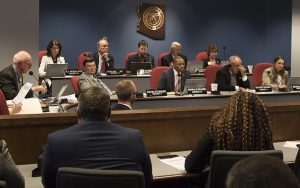PHOENIX – An Arizona legislator wants to create a dyslexia handbook to distribute to traditional public and charter schools.
Rep. Jill Norgaard said students with reading disabilities are more likely to drop out of school. Dyslexics are nearly twice as likely as other students to drop out of school according to a 2012 study by the National Center for Biotechnology Information. Norgaard, a Republican representing Chandler, sponsored the bill.

Members of the House Education Committee consider a bill to require district and charter schools to distribute a state handbook to identify and help students with dyslexia. (Photo by Josh Orcutt/Cronkite News)
The Senate is now considering a bill passed by the House Education Committee that would mean more consistent help for students with dyslexia, a learning disorder making it difficult to read and interpret words.
Nearly 20 percent of students have some form of reading deficiency, with most diagnosed with dyslexia, according to the International Dyslexia Association.
The handbook, which would be required for distribution if passed by the Arizona Legislature, would help teachers and parents identify students with dyslexia. It would also offer strategies and tactics to improve academic performance.
Norgaard, a member of the education committee, said a handbook would offer consistent, standardized learning in Arizona public schools, compared to the scattershot approach to students with dyslexia. Now, approaches differ from one district to the next, or school by school, she said.
“We as a community will be better served if our schools have a common definition of dyslexia and have some resources in their tool bags,” said Stacy Fretheim, who heads the Wellington-Alexander Center for children with dyslexia. The right handbook would help “identify the signs and symptoms of dyslexia as well as how to best do intervention with those kids.”
The handbook incorporates some ideas from 14 states, taking what works best, Norgaard said. She looked closely at Ohio, Alabama and Texas.
Norgaard later hopes to create a pilot program to detect dyslexia early.
“It has been noted in working with some of the pediatric neurologists that we’ve been working with that dyslexia can be decoded successfully” in children as young as three or four, she said.